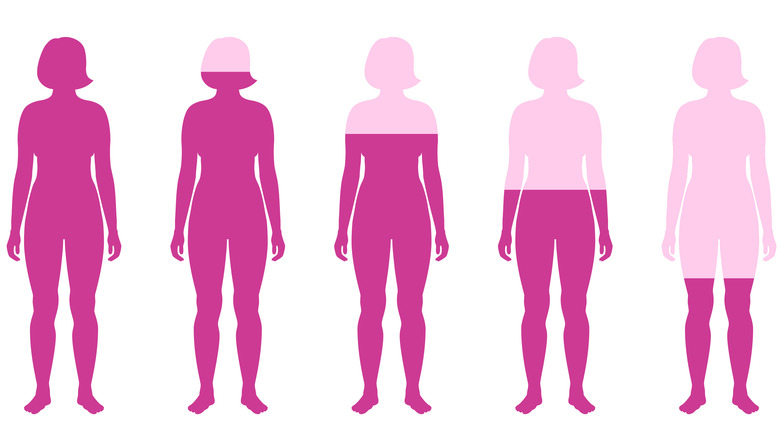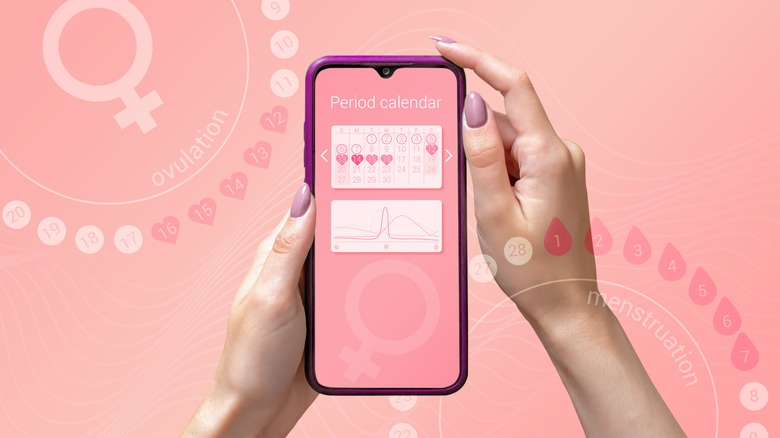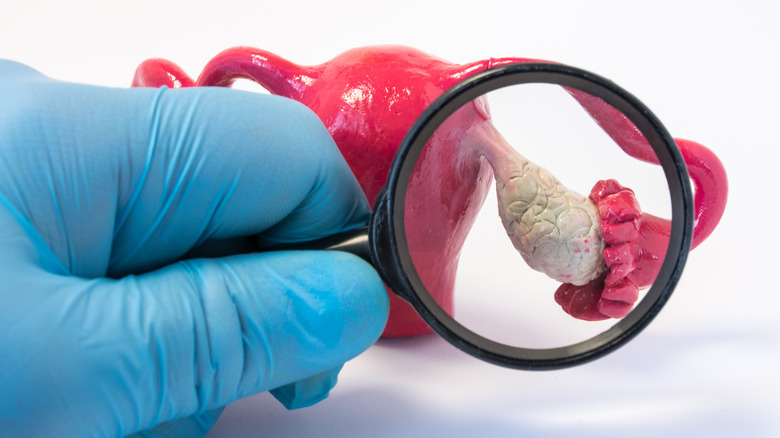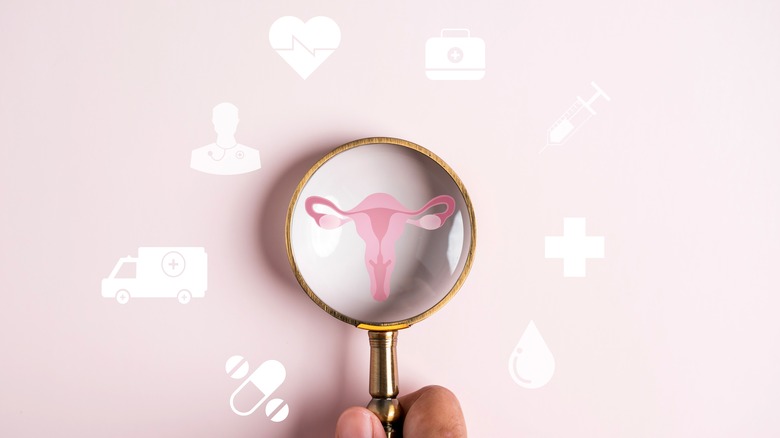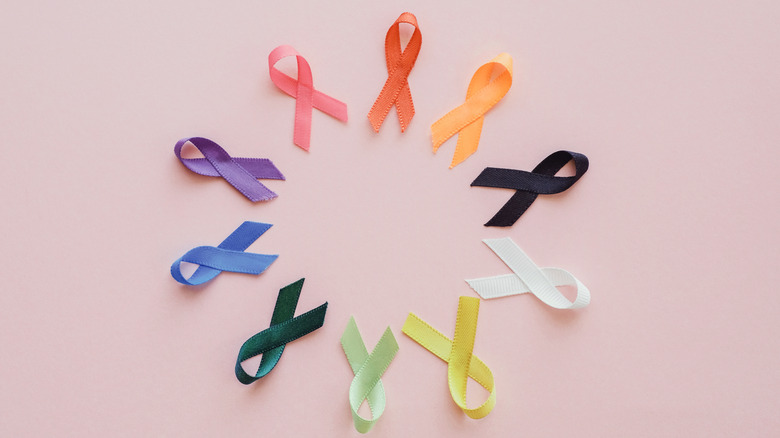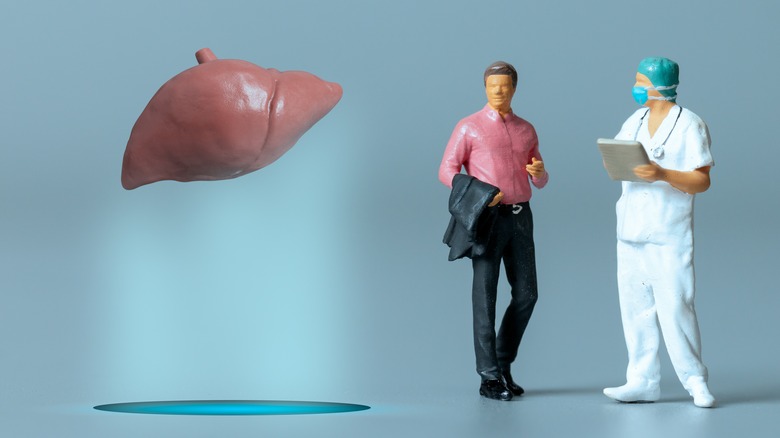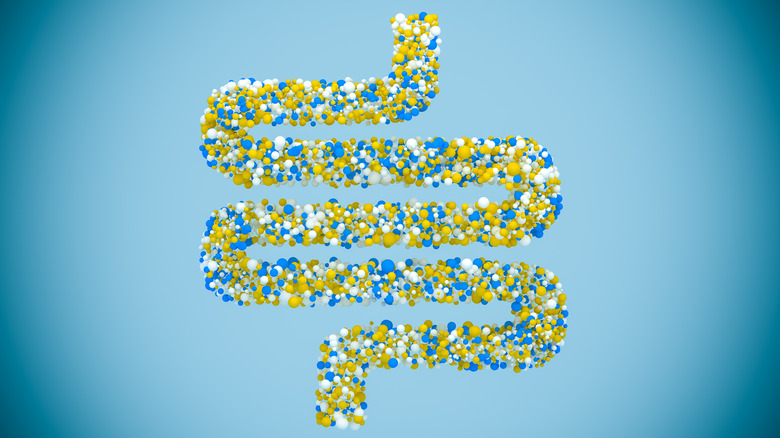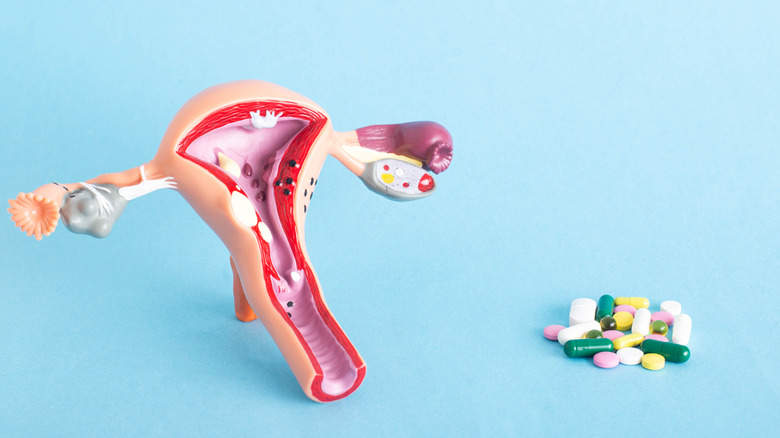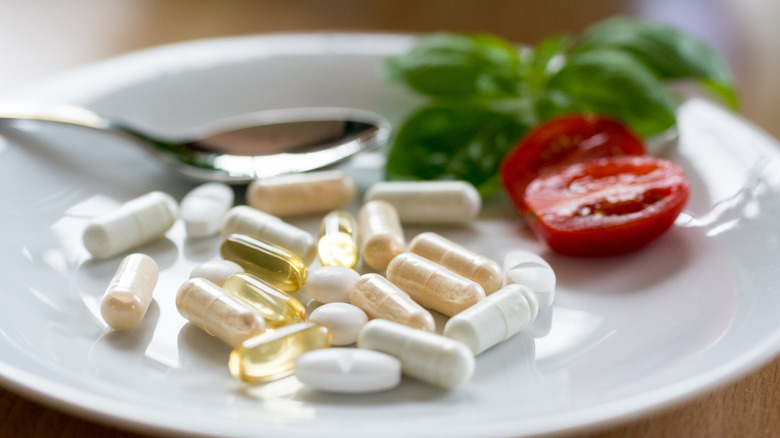Reasons Why Your Estrogen Levels Are High
The human body is a complex network of organ systems working to ensure that we are able to function normally in any given situation. Looking into each organ system reveals even more intricate connections. Take hormones, for example. Hormones are chemical substances produced by certain structures in the body (via MedlinePlus). They are like postal workers, sending out important messages from one place to another. They play a crucial role in many processes, such as growth and development, sex and reproduction, metabolism, and mood.
Estrogen is one of the many hormones our body produces. Although it is often thought of as the hormone produced by females, males also produce estrogen, but to a lesser degree (per Medical News Today). Estrogen is produced by the ovaries, testes, fat cells, and adrenal glands, and it has many reproductive and non-reproductive roles in the body. According to Cleveland Clinic, estrogen is involved in puberty, menstruation, fertility, pregnancy, and menopause in females. On the other hand, estrogen affects sperm production, sex drive, and erectile function in males. In both females and males, estrogen participates in the regulation of your cholesterol levels, blood sugar levels, bone mass, muscle mass, blood flow, collagen production, skin moisture, and brain function.
Although estrogen is an important hormone to have, too much of it can lead to symptoms like gynecomastia (i.e., breast enlargement in males), infertility, depression, and anxiety. Many things can cause fluctuations in your estrogen levels — some are normal, while others are not (via MedicineNet).
Normal menstrual cycle
One of the major things that distinguishes females from males is the menstrual cycle. A menstrual cycle typically lasts between 21 to 35 days, starting on the first day of your period and ending the day before the start of your next period (per Flo Health). According to BYJU'S Learning, girls typically have their first period between 10 to 15 years old, and women typically stop menstruating around 45 to 50 years old.
The menstrual cycle is divided into two parts: the follicular phase and the luteal phase (via Endotext). The follicular phase begins at the start of your period, ends at ovulation, and lasts for approximately 14 days. During this time, follicles in the ovaries are allowed to develop and mature, and their growth is accompanied by a rise in estrogen levels. Another hormone, called luteinizing hormone, increases as well — and when it reaches its peak level, the egg is released from the mature follicle (i.e., ovulation), estrogen levels slightly fall, and the luteal phase begins. During the luteal phase, estrogen and another hormone called progesterone slowly rise to prepare the womb for pregnancy.
If pregnancy does not happen, these two hormones fall and return to baseline, and the cycle restarts again with the onset of your period. But if pregnancy does occur, estrogen and progesterone remain elevated, and other hormones like human chorionic gonadotropin (hCG) are also produced in high amounts (per Babycenter).
Too much body fat
Authors of a 2020 review in Pulmonary Circulation explain that estrogen is produced mostly by the ovaries in women who have not undergone menopause. But in menopausal women and in men, estrogen is primarily produced and metabolized by fat cells. Thus, the more fat cells you have in the body, the higher your estrogen levels are.
With that said, your weight does not necessarily correlate with your estrogen levels. According to Healthline, weight is determined by many factors; body fat is just one of them. Technically speaking, you can gain 10 pounds' worth of fat, but you can also gain 10 pounds' worth of muscle. Gaining muscle does not increase your risk of high blood pressure, diabetes, and heart disease, but excess fat does. Similarly, building more muscle does not increase your estrogen levels, but gaining fat does. Therefore, when it comes to a person's weight, body composition matters.
WebMD explains that health professionals use a variety of tests and instruments to measure your body composition; most importantly, how much of your body is made up of fat. These tests include skin calipers, underwater weighing, body pod machines, and dual X-ray absorptiometry (DEXA) scans. The American College of Sports Medicine (ACDM) released guidelines estimating how much body fat percentage a person has based on their age, gender, and fitness level, as well as recommendations on how much body fat percentage a person should have based on their age and gender. In general, females naturally have a higher body fat composition compared to males.
Constant stress
Just as how physical stress can cause damage to virtually anything around us, stress can directly and indirectly affect almost all processes in our body. The American Institute of Stress lists down the possible widespread effects of stress on each of our organ systems. These include headaches, digestive problems, difficulty breathing, fast heartbeat, palpitations, increase in blood pressure, increase in blood sugar levels, acid reflux, difficulty sleeping, irritability, depression, anxiety, irregular periods, and even infertility.
Stress is able to produce all of these effects on the body because of the hormone cortisol (via University Health News). Your cortisol level increases when you are exposed to stress, which is why it is also known as the stress hormone. It is released by the adrenal glands, two small organs on top of your kidneys. Normally, cortisol helps reduce inflammation, assists with memory formation, and regulates blood pressure levels, blood sugar levels, the sleep cycle, and metabolic processes. However, too much or too little can throw the body off-balance and cause various problems.
According to the U.S. Department of Veteran Affairs, one of the precursors of cortisol is progesterone. When stress causes an increased demand for cortisol, progesterone levels drop. This puts the body in a state of an estrogen-progesterone imbalance, with estrogen levels becoming too high relative to progesterone. This leads to a condition called estrogen dominance, which can be linked to other diseases such as breast cancer, endometriosis, and polycystic ovarian syndrome (PCOS).
Excessive alcohol and caffeine intake
Many of us rely on caffeine to start our day, and some of us cannot wait to relax and end a busy day with a smooth glass of wine or a cold can (or bottle) of beer. While small amounts in moderation of these things are okay, too much too often can cause serious problems.
According to Mayo Clinic, the recommended amount of caffeine a person can consume in a day is around 400 milligrams. The National Institute of Health (NIH) found that estrogen levels are increased in Asian women who drink around 200 milligrams or more of caffeine a day from coffee, but are slightly decreased in White women who drink the same amount. Interestingly, estrogen levels were also found to be increased in Asian, White, and Black women who consumed more than one cup of caffeinated soda or green tea a day.
On the other hand, the Centers for Disease Control and Prevention (CDC) defines moderate alcohol drinking as two drinks or less per day in men, and one drink or less per day in women. Ria Health explains that excessive drinking can affect all hormones in the body, including hormones that regulate emotions (e.g., dopamine, serotonin), stress (i.e., cortisol), bone growth (e.g., parathyroid hormone, calcitonin), blood sugar (e.g., insulin, glucagon), and sexual function (e.g., estrogen, testosterone). Studies show that alcohol can increase estrogen levels in both males and females, increase testosterone in females, and decrease testosterone in males.
High levels of testosterone
If estrogen is the main female hormone, testosterone is the main male hormone. But just as males can produce estrogen, females can produce testosterone as well (via Medical News Today). In males, testosterone plays a vital role in many processes such as sperm production, sex drive, bone mass, fat distribution, muscle mass, and red blood cell production. In females, it also helps maintain bone density, sex drive, and muscle strength, although to a lesser degree.
However, just like any other hormone in the body, fluctuations in testosterone levels can cause serious side effects. According to Harvard Health, low testosterone levels can cause decreased libido, low bone density, depression, decreased body hair, and poor concentration, among other things (per Healthline). On the other hand, while excess testosterone can cause your muscles to get bigger, it can also lead to decreased sperm count, shrunken testicles, infertility, liver problems, high blood pressure, blood clots, mood swings, stunted growth, as well as polycystic ovarian syndrome in women. Additionally, Mantality Health states that people taking testosterone may experience weight gain, because excess testosterone in the body gets converted to estrogen.
High testosterone levels can be due to diseases affecting the pituitary gland (e.g., acromegaly, Cushing syndrome) or the adrenal glands (e.g., tumors, congenital adrenal hyperplasia). It can also be caused by medications (e.g., fluoxymesterone), anabolic steroids, and testosterone supplements (per Medical News Today).
Polycystic ovarian syndrome
Polycystic ovarian syndrome (PCOS) is a condition where the ovaries produce high amounts of male sex hormones (i.e., androgens). Not much is known about how it happens, but what we do know is that it runs in families, and it is related to insulin resistance and obesity. Women with PCOS often experience irregular periods, acne, oily skin, weight gain, excess body hair, male-pattern baldness, thinning hair, and infertility (via Johns Hopkins Medicine).
Understanding how hormone levels are affected by PCOS can be challenging. Some experts, like the National Institute of Child Health and Human Development, explain that because the ovaries in women with PCOS produce more androgens than they should, they end up producing lower levels of estrogen. But other experts such as Penn Medicine and Contemporary OB/GYN state that estrogen levels may be normal or increased, possibly because excess insulin and testosterone in PCOS gets converted to estrogen. Actually, both ideas are correct.
Estrogens can be produced from androgens in both the ovaries and fat cells, but the type of estrogen that is produced is different. Estradiol is produced in the ovaries, while estrone is produced in fat cells (via StatPearls). In the ovaries, the enzyme that converts androgens to estradiol is suppressed, leading to an increased concentration of androgens and decreased concentration of estrogen. But in fat cells, conversion of androgens to estrone is uninhibited, leading to an increased concentration of estrogen.
Other gynecological conditions
Aside from PCOS, other gynecological conditions that can cause relatively high estrogen levels compared to progesterone (i.e., estrogen dominance) include fibroids and endometriosis.
According to Mayo Clinic, uterine fibroids are noncancerous (benign) outgrowths of varying sizes that develop on or within the uterus. They are also called leiomyomas or myomas, and they can grow significantly large and distort the shape of the uterus. A person can have one or many fibroids, but they usually will not develop any symptoms. If you do have symptoms, you may have irregular periods, pelvic pressure or pain, bladder and bowel problems, back pain, and leg pain. Fibroids are sensitive to progesterone and estrogen. The Atlanta Fibroid Center explains that too much estrogen can cause fibroids to grow very large. On the other hand, progesterone keeps estrogen in check and inhibits the growth of fibroids. Therefore, having fibroids can be correlated with high estrogen levels and low progesterone levels.
On the other hand, endometriosis occurs when endometrial tissue (normally found in the innermost lining of the uterus) develops outside of the uterus, such as in the fallopian tubes, uterine ligaments, pelvis, and ovaries. They can also develop on or around the vagina, cervix, bladder, and abdominal organs, although this is rare (per Johns Hopkins Medicine). High levels of estrogen in endometriosis can trigger pain and inflammation, specifically in the areas where the endometrial tissues are located. People with endometriosis may also have heavy periods and infertility (via WebMD).
Certain types of cancer
Estrogen-dependent cancers include cancers of the breast, ovaries, and uterus. There are many types of breast cancer. Some of them make use of hormones to help them grow and spread. Among these, some are sensitive to estrogen, and others are sensitive to progesterone. There are also ones that are sensitive to a protein called HER2, and some that are sensitive to all three substances (i.e., estrogen, progesterone, and HER2). Fortunately, breast cancers that are sensitive to any or all of these substances can be treated using hormone therapy, which involves taking medications that stop your body from producing specific hormones (via the American Cancer Society).
Similarly, Mayo Clinic adds that some types of ovarian cancer also make use of estrogen to help them grow. On the other hand, the uterus is naturally sensitive to estrogen, and unopposed exposure to estrogen is one of the main risk factors related to the development of all uterine (endometrial) cancers (via the MD Anderson Cancer Center).
According to Cleveland Clinic, factors that can increase your risk of developing these estrogen-dependent cancers include hormone replacement therapy, obesity, PCOS, and anything that causes you to have higher-than-normal levels of estrogen. On the contrary, things that can help lower your risk include breastfeeding, not smoking, avoiding alcohol, maintaining a healthy weight, eating healthy, exercising regularly, choosing the right form of birth control, and using combined hormonal therapy or nonhormonal treatments to help with menopause symptoms.
Liver disease
The liver is a large, solid, internal organ located in the right upper area of your abdomen, partly within and partly under your rib cage (per Columbia Surgery). It is responsible for removing harmful toxins and bacteria from the blood, producing albumin and bile, regulating amino acid levels, storing vitamins and minerals, regulating blood clotting, and processing and storing glucose.
According to a 2020 review in Hepatobiliary & Pancreatic Diseases International, many things can go wrong with the liver. Acute forms of injury are often reversible, while chronic forms are not. Chronic liver injury can lead to fibrosis, a process done by the body in an attempt to heal liver damage, but one that also accounts for 45% of all deaths in developed countries. To date, most studies exploring the effect of estrogen on chronic liver disease show that estrogen seems to lower a person's risk of developing liver disease. However, there are also reputable studies that show the complete opposite: increased estrogen levels are somehow associated with chronic liver disease development. Additionally, authors of a 2020 article in LiverTox state that synthetic estrogens found in birth control pills and hormonal replacement therapy are linked to the development of gallstones and many liver problems such as cholestasis, adenomas, and hepatocellular carcinoma.
Despite conflicting results, it cannot be denied that estrogen somehow plays a role in the development of liver diseases. However, more research studies still need to be done in order to confidently establish this relationship.
Intestinal dysbiosis
People often associate microorganisms (i.e., bacteria, viruses, fungi) as harmful. And that makes sense, because we are always told that good hygiene practices will protect us from getting sick. But what if you were told that every surface and lining in your body like your skin, mouth, and gut, are all coated with millions of harmless (and possibly even beneficial) microorganisms? Sounds ridiculous, right? But that is the truth. In fact, according to the Microbiology Society, the total number of harmless bacterial cells on your body is 10 times greater than the number of human cells you have. Essentially, a big chunk of your body is not even human!
Crazy as it all sounds, your microbiome (the collective term for the microorganisms living in and on your body) protects you from harmful germs by preventing them from multiplying and spreading. They work with your immune system, help break down toxic substances that you eat or drink, and synthesize important vitamins (e.g., vitamin B12, vitamin K) and amino acids (via Harvard).
Intestinal dysbiosis occurs when there is an imbalance in your gut microbiome. This puts you at risk of developing diseases like inflammatory bowel disease, irritable bowel syndrome, heart disease, diabetes, obesity, neurological disorders, and cancer (per WebMD). According to Gut Psychology, certain types of bacteria in the gut can affect how well estrogen is removed from the body. Instead of being excreted, estrogen gets converted to its active form and reabsorbed into the bloodstream, causing estrogen levels to rise.
Certain medications
Medications such as hormone replacement therapy (HRT) and birth control pills can raise estrogen levels in your body (per Drugs.com). HRT is often given to women with low hormone levels. As women age, their bodies produce less and less estrogen and progesterone. This is especially evident during menopause, which is why HRT is often given to women in their late 40s to early 50s.
Although low estrogen levels can cause many changes in the body (e.g., hot flashes, mood swings, vaginal dryness), and increase your risk of developing certain illnesses (e.g., osteoporosis, heart disease), HRT is not always the best treatment option. Women who take estrogen alone are at an increased risk of developing uterine cancer because estrogen stimulates the inner lining of the uterus. Most of the time, estrogen is given with progestin to counteract this effect. However, progestin is also linked to an increased risk in breast cancer, which makes it unsafe for women who have breast cancer or an increased risk of developing it (e.g., family history). Side effects of HRT are related to its direct effect of increasing hormone levels. These include weight gain, irregular bleeding, and headaches.
Combined birth control pills or oral contraceptive pills (OCPs) work similarly to HRT in that they contain both estrogen and progesterone. OCPs are mainly given to reproductive-age women to prevent pregnancy. According to Healthline, compared to before, most combined OCPs nowadays only have a small amount of estrogen (low-dose) or none at all (minipill).
Nutrient deficiencies
According to SheCares.com, certain nutrients may also play a role in increasing estrogen levels. However, a lot is still unknown about this link. Hormones & Balance state that magnesium, folic acid, and glutathione are substances that the liver needs in order to process estrogen. Similar to what happens in liver disease, without these substances, the liver is unable to efficiently break estrogen down to be excreted from the body, and estrogen gets reabsorbed back into the bloodstream.
Additionally, researchers of a small 2010 study in Gynecological Endocrinology found that the plasma levels of zinc and copper in 14 women fluctuated in parallel with their menstrual cycles. Specifically, as estrogen levels in the body increased, zinc also increased, while copper decreased. Zinc is a nutrient involved in many processes in the body, including those that help with metabolism, immune system functions, wound healing, taste sensation, and smell (via Mayo Clinic). On the other hand, copper is a mineral that helps the body produce red blood cells, regulate blood pressure and heart rate, absorb iron, prevent inflammation of the prostate, activate the immune system, and promote the development of bones, connective tissues, and organs (per Healthline).
Normally, a healthy and balanced diet is enough to meet our daily vitamin, nutrient, and mineral requirements, but people with low levels may need to actively supplement their diet with specific types of food, or possibly supplements.
External exposure
Estrogen is a hormone that is naturally produced by the body. Interestingly, certain chemicals around you may mimic estrogen and produce the same effects on your body when exposed. These chemicals are called xenoestrogens, and they can be found in many common items that you use. Balanced Concepts lists possible sources of xenoestrogens, and these include agricultural chemicals (e.g., pesticides, herbicides, fertilizers), cosmetics (e.g., nail polish, hairspray, perfume), toiletries (e.g., sunscreen, lotion, shampoo), plastic containers, household cleaners (e.g., laundry detergent, fabric softener, dryer sheets), insect repellents, air fresheners, and some bodies of water.
Currently, there is still much to be learned about how exactly xenoestrogens affect the human body (if at all). But researchers of a 2013 study published in the journal Steroids are making headway toward better understanding their effects. They found that compared to just analyzing the effects of xenoestrogens on their own, mixing xenoestrogens with endogenous (natural) estrogen showed more profound effects on the endocrine system (the organ system mostly responsible for the regulation of hormones). However, until research reveals at what concentrations these xenoestrogens are active, and whether or not those concentrations are what we are exposed to in our environment, the real risk of exposure to xenoestrogens will remain unclear.
Phytoestrogens from food
Healthline warns that what you eat may also affect your estrogen levels and possibly increase your risk of developing estrogen dominance. Particularly, the Western-type diet prevalent in the United States consists mainly of red meat, processed food, sweets, dairy products, and refined grains. Studies show that this promotes weight gain and obesity, increases estrogen levels, and increases the risk of developing breast cancer. Meanwhile, Mediterranean, fiber-rich, and plant-based diets have been shown to maintain healthy levels of estrogen in the body. These diets are rich in phytoestrogens, substances that can increase or decrease estrogen levels in the body. Examples of food rich in phytoestrogens are fruits, vegetables, grains, nuts, soy, legumes, and seeds.
The finding that phytoestrogen consumption is beneficial to your health may seem contradictory to the finding that the Western-type diet is harmful, since both of them seem to cause an increase in your body's estrogen levels. However, Healthline states that studies on the consumption of phytoestrogens (which are plant-based) have not shown any adverse outcomes. On the contrary, many studies show that they may even help in relieving hot flashes, decreasing the risk of osteoporosis, treating acne, preventing heart disease, and protecting against breast cancer (per Medical News Today).
While we wait for more data that would solidify the benefits of incorporating phytoestrogens in our diet, it is important to remember that each person's diet can vary depending on what they need. The only way to follow the right one with certainty is by consulting with a doctor and/or a dietitian.

